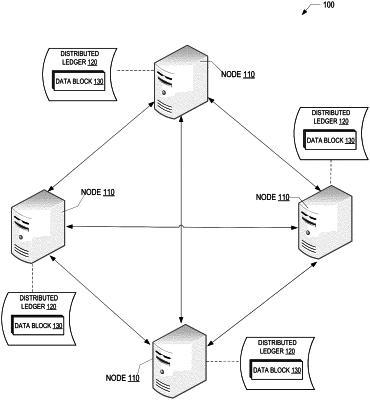| CPC G06Q 20/40145 (2013.01) [G06Q 20/206 (2013.01); G06Q 2220/165 (2013.01)] | 19 Claims |

|
1. A system for enhanced authentication at a resource event apparatus, the system comprising:
a distributed trust computing network comprising a plurality of decentralized nodes, each decentralized node configured to store at least a portion of a distributed ledger comprising a plurality of data blocks;
a first computing platform including a first memory and at least one first processing device in communication with the first memory, wherein the first memory stores a non-fungible token generation sub-system that includes first instructions that are executable by the at least one first processing device and are configured to:
in response to producing a card device configured for executing resource events, generate a first non-fungible token (NFT) associated with the card device; and
communicate the first NFT to the distributed trust computing network;
wherein in response to the distributed trust computing network receiving the first NFT, the decentralized nodes of the distributed trust computing network are configured to (i) reach a consensus on the first NFT to verify an authenticity of the first NFT, and (ii) generate a data block, within the distributed ledger, that stores the verified first NFT;
issuing the card device to the user, which comprises to generate a second non-fungible token (NFT) that is (i) associated with an identification of the user and (ii) linked to the first NFT, wherein the second NFT is generated by using an image of the user as an input to a hash algorithm;
communicate the second NFT to the distributed trust computing network,
wherein in response to the distributed trust computing network receiving the second NFT, the decentralized nodes of the distributed trust computing network are configured to (i) reach a consensus on the second NFT to verify an authenticity of the second NFT, and (ii) generate a data block, within the distributed ledger, that stores the second NFT;
a second computing platform including a second memory and at least one second processing device in communication with the second memory, wherein the second memory stores an authentication sub-system that includes second instructions that are executable by the at least one second processing device and are configured to:
in response to a user presenting the card device at a resource event apparatus, receive first NFT-related information from at least one of (i) the card device or (ii) a digital wallet of the user;
determine whether the first NFT-related information matches the first NFT stored on the distributed ledger of the distributed trust computing network;
in response to determining that the first NFT-related information matches the first NFT stored on the distributed ledger of the distributed trust computing network, authenticate the card device; and
in response to determining that the first NFT-related information does not match the first NFT stored on the distributed ledger of the distributed trust computing network, deny the user from conducting resource events at the resource event apparatus using the card device.
|